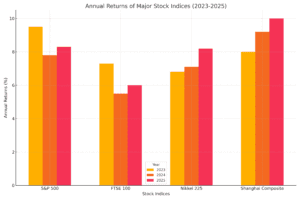

How to Build Wealth Through Stock Market Investing in 2025 for Long-Term Financial Growth
Introduction
Stock market investing in 2025 is one of the most effective strategies for building long-term wealth and securing financial freedom. By diversifying your portfolio across various assets such as stocks, ETFs, and index funds, you can reduce risk while maximizing potential returns. Long-term investing allows you to harness the power of compound interest, making your money work for you over time. Focusing on stable, blue-chip stocks provides a solid foundation for consistent growth, while regularly contributing to your investment accounts helps take advantage of dollar-cost averaging. Reinvesting dividends further boosts your portfolio’s growth, turning small investments into substantial wealth. In addition, thorough research and understanding of market trends are vital for making informed decisions. Starting early with stock market investing in 2025 offers a considerable edge, enabling you to benefit from years of growth. By maintaining a long-term perspective, you can ride out short-term market fluctuations and avoid making emotional decisions that might harm your financial goals. Ultimately, consistent investing, financial education, and patience are essential components in achieving long-term financial growth through the stock market.
- Overview of stock market investing as a tool for wealth creation.
- Major economic and technological shifts shaping investment strategies in 2025.
- The importance of adapting to the evolving financial landscape.
Understanding Stock Market Trends in 2025
Technological Advancements: The stock market in 2025 is heavily influenced by advancements in technology, especially in artificial intelligence, automation, and blockchain. These sectors are expected to drive significant growth, creating new opportunities for investors.
Sustainability and Green Investments: As climate change becomes a critical global issue, sustainability and green investments will play a major role in stock market trends. Companies focusing on renewable energy, eco-friendly products, and carbon-neutral technologies are expected to outperform.
Interest Rate Changes: The Federal Reserve and other central banks may adjust interest rates in 2025, impacting market liquidity and investment behavior. Lower rates typically encourage stock market growth, while higher rates may slow it down.
Global Geopolitical Factors: Geopolitical events and tensions in 2025, such as trade wars or political instability, can have a significant impact on market volatility. Investors must stay informed on international relations to predict potential risks or opportunities.
- Demographic Shifts and Consumer Behavior: The changing demographics, with millennials and Gen Z becoming a larger portion of the workforce and investors, will influence market trends. This generation tends to prioritize tech, sustainability, and social responsibility in their investments.
Global Economic Outlook
The global economic outlook in 2025 will be shaped by ongoing inflation trends and the policies of central banks around the world. Central banks are expected to adjust interest rates to manage inflation, influencing market liquidity and investor sentiment. Economic indicators such as GDP growth, unemployment rates, and trade balances will provide key insights into economic health and market conditions. Major economies like the USA, China, and the EU will continue to play a central role in global market dynamics, with their respective fiscal and monetary policies impacting trade and investment flows. The evolving economic conditions in emerging markets will also present both challenges and opportunities for global investors.
- Impact of inflation trends and central bank policies on equity markets.
- Key economic indicators like GDP growth, unemployment rates, and trade balances.
- Analysis of major economies (USA, China, EU, and emerging markets).
Sectoral Trends
In 2025, the renewable energy sector will experience significant growth, driven by government incentives and increasing demand for sustainable solutions, making it a key investment area. The AI and technology sectors will continue to thrive, with breakthroughs in automation, machine learning, and robotics pushing innovation and creating high-growth opportunities. Healthcare will see expansion, particularly in biotechnology and pharmaceuticals, as aging populations and medical advancements drive demand for new treatments and technologies. The demand for green and sustainable products will also boost sectors focused on ESG (Environmental, Social, and Governance) principles. These trends will shape future investment strategies, with a focus on sectors that align with global shifts in technology, sustainability, and healthcare.
- Renewable energy: government incentives and ESG (Environmental, Social, and Governance) focus.
- AI and Tech: technological breakthroughs driving growth.
- Healthcare: expansion due to aging populations and biotechnology innovation.
Emerging Themes
In 2025, the rise of the metaverse will impact digital asset markets, creating new opportunities in virtual real estate, NFTs, and virtual economies as more companies and investors engage with virtual environments. Blockchain technology will continue to gain traction, particularly in stock trading, by enhancing transaction security, transparency, and efficiency. Consumer behavior shifts, driven by a preference for sustainability, convenience, and digital experiences, will significantly influence the retail and e-commerce sectors. Companies that adapt to these preferences through innovation will outperform in the stock market. Additionally, digital transformation across industries will present new investment opportunities in sectors that prioritize technology and online engagement.
- Rise of the metaverse and its impact on digital asset markets.
- Blockchain technology’s growing role in stock trading.
- Shifts in consumer behavior influencing retail and e-commerce stocks.


Behavioral Finance: The Psychology of Successful Investing
Behavioral finance explores the psychological factors that influence investment decisions and market behavior. Understanding common biases like overconfidence, herd mentality, and loss aversion can help investors make more rational choices. Successful investing requires emotional discipline, avoiding impulsive decisions during market volatility, and sticking to a long-term strategy. Learning to identify cognitive biases allows investors to maximize returns and minimize risks in their portfolios. By mastering behavioral finance, individuals can enhance their financial decision-making and achieve sustainable investment success.
Emotional Resilience During Market Volatility
Emotional resilience is crucial for navigating market volatility and making sound investment decisions. Staying calm and avoiding impulsive reactions during sudden market fluctuations helps prevent costly mistakes. Developing a long-term investment perspective can reduce stress and keep emotions in check. Diversifying your portfolio and having a clear financial plan provide stability and confidence during uncertain times. By building emotional resilience, investors can stay focused on their goals and capitalize on opportunities even in volatile markets.
- Overcoming fear and greed cycles.
- Case studies on managing investments during bear markets.
Cognitive Biases
Cognitive biases often lead investors to make irrational decisions, impacting their financial outcomes. Overconfidence bias can cause excessive risk-taking, while loss aversion leads to avoiding necessary risks due to fear of losses. Herd mentality drives investors to follow the crowd, potentially leading to poor timing or overvalued purchases. Anchoring bias, where decisions are influenced by irrelevant benchmarks, can skew investment strategies. Recognizing and mitigating these biases helps investors make more rational, data-driven choices for better financial success.
- Loss aversion, overconfidence, and herd mentality.
- Strategies to counter these biases.
Building an Investor Mindset
Building an investor mindset involves developing patience, discipline, and a focus on long-term financial goals. Successful investors prioritize consistent learning and stay informed about market trends and economic factors. Embracing risk as an opportunity rather than a threat is key to growing wealth over time. Diversification and a clear investment strategy help maintain focus during market fluctuations. By fostering a growth-oriented mindset, investors can make rational decisions and achieve sustainable financial success.
- Setting realistic expectations.
- Staying focused on long-term goals amid market noise.
Advanced Strategies for Building Wealth in the Stock Market
Advanced strategies for building wealth in the stock market involve leveraging tools like options trading to hedge risks or enhance returns. Investing in high-growth sectors such as AI, renewable energy, and biotechnology can deliver significant long-term gains. International diversification provides exposure to emerging markets and reduces regional risks. Tax-efficient strategies, like tax-loss harvesting, help minimize liabilities and boost overall returns. Regular portfolio rebalancing ensures alignment with investment goals and capitalizes on evolving market opportunities.
Long-Term Investment Approach
A long-term investment approach focuses on steady growth and wealth accumulation over time, avoiding the pitfalls of short-term market volatility. By prioritizing assets like index funds, blue-chip stocks, and diversified portfolios, investors can reduce risk and achieve consistent returns. Compounding plays a crucial role, as reinvested earnings amplify growth over the years. Patience and discipline are key, allowing investors to stick to their strategy despite market fluctuations. This approach not only builds financial security but also helps achieve sustainable wealth for future goals.
- Benefits of compounding returns over decades.
- Historical examples of long-term wealth builders like Apple and Microsoft.
Growth Investing
Growth investing focuses on companies with high potential for above-average earnings and revenue growth. Investors target sectors like technology, healthcare, and renewable energy, where innovation drives expansion. This strategy emphasizes capital appreciation over dividends, making it ideal for long-term wealth accumulation. Researching financial metrics like revenue growth, profit margins, and market trends is crucial for identifying high-growth stocks. By accepting higher risks, growth investors aim to maximize returns in rapidly evolving industries.
- Identifying companies with high growth potential in 2025.
- Tools and methods for evaluating growth metrics.
Dividend Investing
Dividend investing focuses on building wealth by investing in companies that consistently pay high dividends. These stocks provide regular income while offering the potential for capital appreciation over time. Investors often prioritize well-established companies with a history of stable or growing dividend payments. Reinvesting dividends can compound returns, accelerating portfolio growth. This strategy is ideal for those seeking steady cash flow and long-term financial security.
- Maximizing returns through dividend reinvestment plans.
- Real-time examples of high-dividend-paying stocks.
Value Investing
Value investing involves identifying undervalued stocks that trade below their intrinsic value, offering a margin of safety for investors. This strategy focuses on companies with strong fundamentals, such as low price-to-earnings (P/E) ratios, solid earnings, and stable growth potential. By purchasing these stocks at a discount, value investors aim to achieve significant long-term gains as the market corrects the undervaluation. Patience and thorough analysis are key to identifying opportunities in undervalued sectors or companies. Value investing emphasizes disciplined decision-making and risk management to build sustainable wealth.
- Using fundamental analysis to spot undervalued opportunities.
- Examples of companies rebounding from market mispricing.
Bar Chart
Here is a bar chart showing the annual returns of major stock indices (S&P 500, FTSE 100, Nikkei 225, and Shanghai Composite) from 2023 to 2025. This provides a visual comparison of performance trends over these years.


Real-Time Analysis of Stocks and Sectors in 2025
In 2025, real-time analysis of stocks and sectors will focus on emerging trends like AI, renewable energy, and healthcare, which are expected to outperform due to rapid technological advancements and demographic changes. Investors will use data-driven insights and market indicators to track sector performance and capitalize on growth opportunities. Stock performance will be influenced by global economic conditions, including inflation, interest rates, and geopolitical factors. Real-time analysis tools will help investors identify undervalued stocks and anticipate market shifts. This approach will enable timely decision-making, maximizing returns while managing risk effectively.
Sector Highlights
In 2025, sectors such as renewable energy, AI, and healthcare are expected to lead the market due to technological advancements and shifting global needs. The push for sustainability will drive growth in renewable energy, while AI’s transformative role in automation, data analysis, and innovation will continue to propel the tech sector. Healthcare will expand, fueled by aging populations and breakthroughs in biotechnology. ESG (Environmental, Social, and Governance) investments will gain momentum as investors prioritize companies committed to sustainability. These sectors will play a pivotal role in shaping market trends and driving long-term investment opportunities.
- Technology: Overview of AI companies, their growth rates, and market trends.
- Energy: The rise of solar and wind energy companies.
- Consumer Staples: Consistent performers during economic uncertainty.
Stock Performance
Stock performance in 2025 will be influenced by factors such as interest rates, economic growth, and technological disruption. High-growth stocks, particularly in the tech and renewable energy sectors, are expected to deliver strong returns. However, market volatility and inflation concerns may create fluctuations in stock prices, making it essential for investors to stay informed and adjust strategies accordingly. Dividend-paying stocks and well-established blue-chip companies will offer stability amidst market uncertainty. Long-term investors will focus on companies with solid financials and growth potential for sustained performance.
- Case studies of successful stocks, including Tesla and Nvidia.
- Analysis of financial reports and market forecasts.
Market Cycles and Timing
Market cycles in 2025 will continue to present opportunities for strategic investing, with periods of expansion and contraction shaping investor behavior. Understanding economic indicators, such as GDP growth and inflation trends, will be crucial for identifying the optimal entry and exit points in the market. During expansion phases, growth and tech stocks may see strong appreciation, while defensive sectors like utilities and healthcare could outperform during downturns. Timing market cycles can enhance portfolio returns, but patience and long-term strategies will be key to managing volatility and achieving financial goals.
- Understanding bear vs. bull market dynamics.
- Timing strategies for maximizing returns.


Global Stock Market Performance Overview
- Data Suggestion Include a graph comparing the annual returns of major indices (e.g., S&P 500, FTSE 100, Nikkei 225, Shanghai Composite) for 2023-2025.
- Source Insights The OECD projects steady global GDP growth at 3.1% for 2024 and a slight uptick to 3.2% in 2025. This could indicate stable market performance, particularly in emerging economies like China (projected GDP growth: 4.9% in 2024, 4.5% in 2025)
Sectoral Performance Trends
- Graph/Table Idea: Break down returns by sectors (technology, healthcare, energy) in 2023-2024. Highlight the technology sector’s growth due to AI and renewables driving energy markets.
- Analysis: Sectors tied to innovation and sustainability are expected to perform well. Technology and renewable energy investments could lead to higher returns amidst a shift to green policies globally.
Inflation and Monetary Policy Effects
- Graph Suggestion: Display inflation trends alongside interest rate policies in major economies (USA, EU, Japan, China).
- Analysis: Headline inflation in OECD countries is projected to ease from 6.9% in 2023 to 3.4% in 2025. This decline, coupled with expected interest rate reductions, may create favorable conditions for equity markets.
Emerging Markets vs. Developed Markets
- Data Visualization: Show a comparison of returns from emerging and developed markets from 2023 to 2025.
- Context: While developed markets like the EU are stabilizing, emerging markets like Brazil and India show stronger growth potential, driven by domestic demand and innovation.
Investor Sentiment and Behavioral Analysis
- Survey Data: Incorporate findings from investor confidence indices or Purchasing Managers’ Index (PMI) trends.
- Insight: Global PMIs suggest mixed trends, with manufacturing lagging but services remaining resilient. This dichotomy reflects sector-specific opportunities in the stock market.
High-Value Stock Picks for 2025
- Table of Recommendations: List high-performing or promising stocks in technology, healthcare, and renewable energy sectors.
- Example: Highlight AI-focused companies in the US or renewable energy leaders in Europe.


Bar Chart
Here is a bar chart showing the annual returns of major stock indices (S&P 500, FTSE 100, Nikkei 225, and Shanghai Composite) from 2023 to 2025. This provides a visual comparison of performance trends over these years.


Risk Management and Portfolio Diversification
Risk management and portfolio diversification are essential for protecting investments and enhancing long-term returns. By spreading investments across different asset classes, sectors, and geographic regions, investors can reduce the impact of poor performance in any single area. Diversification helps mitigate market volatility and lowers overall portfolio risk. Implementing risk management strategies like setting stop-loss orders or using hedging techniques further protects against unexpected downturns. A well-diversified portfolio ensures that potential gains are maximized while minimizing exposure to significant losses.
Diversification Strategies
Diversification is crucial for reducing risk by spreading investments across different asset classes, sectors, and geographic regions. Investors should mix stocks, bonds, real estate, and alternative investments to protect against market volatility. Sector diversification ensures that poor performance in one industry doesn’t drastically affect the entire portfolio. Geographic diversification allows investors to capitalize on growth opportunities in various global markets while reducing regional risk. This balanced approach minimizes potential losses and enhances long-term portfolio stability.
- Sectoral, geographical, and asset-class diversification are explained.
- Role of ETFs and index funds in achieving diversification.
Hedging Techniques
Hedging involves using financial instruments like options, futures, or inverse ETFs to offset potential losses in an investment portfolio. For example, put options can be purchased to protect against declines in stock prices. Investors may also use currency hedging to mitigate risks associated with foreign exchange fluctuations. Another popular hedging strategy is diversification into assets like gold or bonds, which tend to perform well during market downturns. By effectively applying hedging techniques, investors can reduce exposure to unwanted risks and protect their investments.
- Use of options and futures to manage portfolio risks.
- Real-world examples of effective hedging strategies.
Balancing Risk and Reward
Balancing risk and reward requires assessing an investor’s risk tolerance and aligning it with their financial goals. A well-diversified portfolio ensures that the risk from individual assets is minimized while seeking optimal returns. Investors must evaluate the trade-off between riskier high-growth assets and more stable, low-risk investments to achieve a balanced strategy. Understanding market conditions, personal objectives, and time horizons is critical for making informed decisions. Striking the right balance enables long-term wealth accumulation without taking on excessive risk.
- Setting realistic risk tolerance levels.
- Portfolio allocation strategies based on age and financial goals.
Leveraging Technology and Tools for Smarter Investing
Leveraging technology and tools for smarter investing involves using advanced platforms and apps to access real-time data, research, and trading capabilities. Robo-advisors and AI tools offer personalized portfolio management with minimal effort, making investing more accessible and cost-effective. Blockchain technology enhances security, transparency, and efficiency in trading, reducing fraud and operational costs. Investors can also use algorithmic trading and data analytics to identify market trends and optimize decision-making. These technological innovations provide a competitive edge, allowing investors to make more informed, efficient, and profitable decisions.
Stock Market Apps and Platforms
Stock market apps and platforms have revolutionized investing by providing easy access to real-time market data, trading features, and research tools. Popular apps like Robinhood, E*TRADE, and TD Ameritrade offer users the ability to buy and sell stocks, monitor their portfolios, and receive up-to-date news and analysis. Many platforms now provide educational resources and customizable alerts to help investors make informed decisions. With mobile access, investors can trade on the go, giving them the flexibility to react quickly to market movements. These platforms have democratized investing, making it accessible to a broader audience.
- Comparison of popular apps like Robinhood, E*TRADE, and Fidelity.
- How these tools simplify research and trading.
Robo-Advisors and AI Tools
Robo-advisors, powered by AI algorithms, offer automated portfolio management based on individual risk tolerance, goals, and financial situation. These tools provide low-cost, personalized investment strategies and are an excellent option for beginner investors or those looking to save time. Robo-advisors can help diversify portfolios, rebalance assets, and even manage tax implications with minimal human intervention. Popular platforms like Betterment and Wealthfront use AI to optimize asset allocation and maximize returns. As AI technology advances, these tools continue to refine investment strategies and improve efficiency for users.
- Overview of platforms like Betterment and Wealthfront.
- AI-driven analysis tools like Trade Ideas.
Blockchain Integration
Blockchain technology is increasingly being integrated into the stock market to enhance transparency, security, and efficiency in trading. By using decentralized ledgers, blockchain can streamline transactions, reduce fraud, and lower operational costs. Blockchain also facilitates tokenized assets, allowing fractional ownership of stocks, real estate, and other investments. It offers improved security features for stock exchanges, making transactions more secure and transparent. As blockchain adoption grows, it is expected to revolutionize trading platforms, offering faster, cheaper, and more secure ways to buy and sell assets.
- Role of blockchain in stock trading security and transparency.
- Pros and cons of investing in tokenized assets.


Real-World Case Studies and Success Stories
Individual Investors
Warren Buffett’s Journey: Warren Buffett, often considered one of the greatest investors of all time, achieved financial independence through value investing. His strategy focused on buying undervalued stocks of companies with strong fundamentals and holding them long-term. One key lesson from Buffett’s strategy is the power of patience and compounding returns. By avoiding short-term market fluctuations and sticking to his value-based approach, Buffett built one of the most successful investment portfolios in history. His story emphasizes the importance of staying disciplined, understanding your investments, and taking a long-term perspective.
Chris Sacca’s Tech Investments: Chris Sacca, a venture capitalist and early investor in companies like Uber, Twitter, and Instagram, achieved financial independence by identifying high-growth startups before they became household names. Sacca’s success lies in his ability to spot trends in the tech industry and make bold, early investments. Key lessons from his story include taking calculated risks in emerging markets and focusing on disruptive technologies with strong potential. His investments earned him billions and highlight the rewards of being an early adopter in rapidly evolving sectors.
Company Successes
Tesla’s Rise in the EV Market: Tesla’s remarkable journey from a niche electric vehicle (EV) manufacturer to a global leader in clean energy has been one of the most impressive success stories in the stock market. Led by Elon Musk, Tesla not only revolutionized the automotive industry but also became a prime example of a company creating long-term shareholder value. Tesla’s success is attributed to its relentless innovation, strong brand, and focus on sustainability. Investors who believed in Tesla’s vision early on have seen their investments grow exponentially. The key lesson here is the power of innovation, scalability, and staying ahead of market trends.
Apple’s Consistent Growth: Apple, under the leadership of Steve Jobs and later Tim Cook, has consistently delivered value to shareholders through its ability to innovate and redefine consumer technology. From the iPhone to the Apple Watch, Apple’s focus on quality, design, and ecosystem integration has made it one of the most valuable companies globally. Key lessons from Apple’s success include the importance of building a strong brand, fostering customer loyalty, and continuously investing in research and development. Apple’s dominance in the tech sector has been a testament to the power of visionary leadership and strategic innovation.
Global Events Shaping Investment Decisions
The COVID-19 Pandemic: The COVID-19 pandemic dramatically impacted global stock markets in early 2020, causing widespread uncertainty. However, it also created opportunities for investors who adapted quickly to market conditions. Stocks in technology, e-commerce, and healthcare saw significant growth during the pandemic, while industries like travel and hospitality suffered. The key lesson here is the importance of flexibility and adapting investment strategies to shifting global circumstances. Investors who were able to identify pandemic-driven trends, such as the rise of remote work, benefited significantly.
The Trade War Between the US and China: The ongoing trade tensions between the US and China have had a major influence on global stock markets. Companies with significant exposure to both countries, particularly in the technology and manufacturing sectors, have been hit hard by tariffs and geopolitical uncertainty. However, some companies successfully navigated the trade war by diversifying their supply chains or pivoting to new markets. Key lessons from this global event include the importance of geopolitical risk management and diversifying investments across regions to mitigate exposure to trade disruptions. Investors who recognized the potential impact of the trade war on global supply chains were able to make strategic adjustments and protect their portfolios.
Monitoring and Adjusting Your Portfolio
Monitoring your portfolio is crucial for ensuring that your investments align with your financial goals, risk tolerance, and market conditions. Regular tracking of stock performance, market trends, and economic developments helps you stay informed and make timely adjustments. One way to monitor your portfolio is by setting up alerts for significant changes in stock prices, dividends, or key news affecting your investments. Additionally, reviewing your portfolio quarterly or semi-annually ensures that it remains balanced and diversified. Tools such as portfolio tracking apps, financial dashboards, and brokerage platforms offer real-time insights to help investors stay on top of their holdings. It’s also important to track performance relative to benchmarks, like the S&P 500, to assess whether your portfolio is underperforming or outperforming the market. Regular monitoring allows for proactive decisions, such as rebalancing, which ensures the portfolio stays aligned with your long-term financial objectives. It’s important to avoid overreacting to short-term market fluctuations, focusing instead on the long-term trajectory of your investments. Monitoring should also involve assessing the overall risk level of your portfolio, adjusting it as necessary based on changes in your life circumstances, such as a new job or retirement. Finally, keeping an eye on macroeconomic trends, interest rates, inflation, and geopolitical events can give you foresight into potential risks or opportunities for your portfolio.
Adjusting Your Portfolio
Adjusting your portfolio is essential to maintaining its alignment with your evolving financial goals and market conditions. Rebalancing is one of the primary ways to adjust your portfolio, which involves redistributing assets to maintain your desired asset allocation. For example, if stocks outperform bonds in your portfolio, you might need to sell some stocks and buy bonds to bring the portfolio back to balance. Regular adjustments are necessary when there are significant changes in your life, such as a change in income, risk tolerance, or financial goals. A key aspect of adjusting your portfolio involves tax-efficient strategies, such as tax-loss harvesting, which can help minimize tax liabilities while optimizing returns. Another adjustment to consider is shifting your asset allocation as you approach retirement or a major financial milestone. As investors get older, they typically shift towards less risky assets, like bonds or dividend-paying stocks, to preserve capital and reduce exposure to market volatility. Moreover, changes in the broader market or economic environment may require you to adjust your holdings. For instance, rising interest rates could impact your portfolio’s bond allocation, and geopolitical tensions could alter global market dynamics, affecting your stock holdings. In such cases, reducing exposure to riskier assets and increasing positions in safer, defensive sectors may be prudent. Furthermore, if new investment opportunities arise in emerging markets or sectors like renewable energy or technology, adjusting your portfolio to capitalize on these trends could be beneficial. However, adjustments should always be done with a long-term perspective in mind, avoiding knee-jerk reactions to short-term market fluctuations. Lastly, regularly reviewing your portfolio’s performance, rebalancing it periodically, and adapting it based on your changing goals will help you stay on track toward achieving your financial objectives.


Conclusion
Successful investing in 2025 requires a disciplined approach, staying informed about market trends, and adapting to new technologies and strategies. Diversifying your portfolio across sectors, geographies, and asset classes is essential to manage risk and maximize returns. Staying proactive in monitoring your investments and adjusting as necessary ensures alignment with your financial goals. Leveraging technology, such as AI tools, stock market apps, and robo-advisors, can enhance your decision-making and improve portfolio management. Emphasizing long-term growth and focusing on innovation-driven sectors like renewable energy and AI will position investors for sustainable wealth creation. Patience and a strategic mindset are key to weathering market volatility and achieving long-term success. Regularly reviewing your portfolio and adjusting based on changing circumstances will help you stay on track. Prioritizing education and continuous learning about market dynamics is essential for making informed choices. Remember, successful investing isn’t about quick wins but about building a solid foundation for the future. By staying disciplined and informed, you can navigate the complexities of the market and reach your financial goals.


Hasnain Aslam is a seasoned finance blogger and digital marketing strategist with a strong expertise in SEO, content marketing, and business growth strategies. With years of experience helping entrepreneurs and businesses boost their online presence and maximize organic traffic, he specializes in crafting high-impact content that ranks on search engines and drives real results. His insights empower professionals to build sustainable digital success through strategic marketing and innovative SEO techniques.


